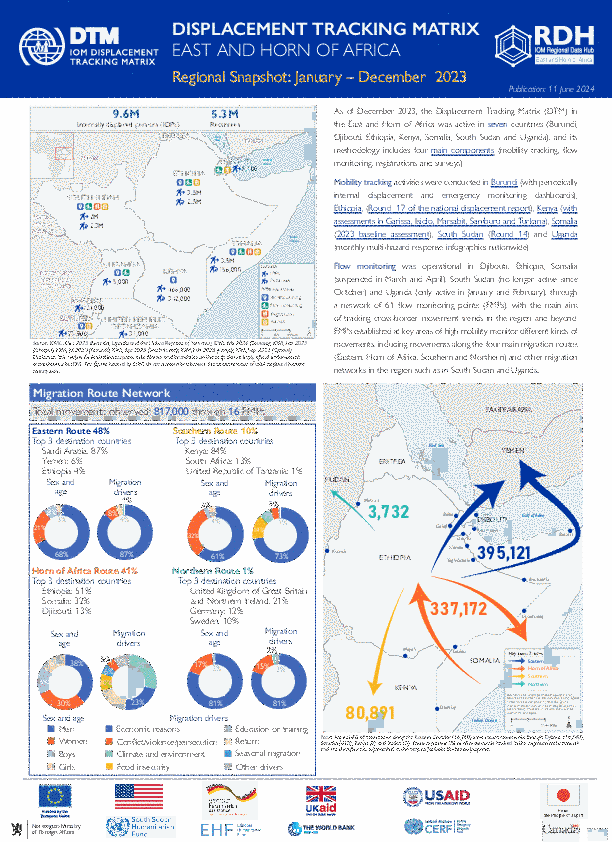-
Countries
-
Data and Analysis
-
Special Focus
-
Crisis Responses

Contact
DTM DRC, iomdrcdtm@iom.int
Language
French
Location
Democratic Republic of the Congo
Period Covered
Apr 30 2024
May 28 2024
Activity
- Mobility Tracking
- Event Tracking
La partie orientale de la République démocratique du Congo (RDC), en particulier au Nord-Kivu, est en proie à un conflit de plus en plus complexe et persistant. Ce conflit est caractérisé par la présence de divers groupes armés tels que le groupe M23, les Forces Armées Congolaises (FARDC) et leurs alliés respectifs. L'expansion des conflits pendant les six premiers mois de 2023 a entraîné un déplacement substantiel de civils, une forte augmentation de la présence des acteurs armés dans le Nord-Kivu et des dégâts humains et matériaux.
La population des agglomérations déstabilisées situées à cheval entre les provinces du Nord-Kivu et Sud-Kivu a augmenté le nombre de déplacements. Malgré les appels généralisés en faveur d’une résolution pacifique du conflit de la part des acteurs régionaux et internationaux, les efforts conjoints pour faciliter le dialogue et négocier des cessez-le-feu ont régulièrement été perturbés.
Du 30 avril au 28 mai 2024, le contexte a été caractérisé par une expansion des combats dans le Nord-Kivu, avec l'utilisation de munitions lourdes causant des dégâts significatifs et des pertes en vies humaines dans les sites de déplacement autour de Goma et Minova dans la province du Sud-Kivu. Toutes les zones touchées souffrent d'une pénurie de ressources et d'opportunités économiques, ainsi que de l'insécurité causée par la prolifération des armes. Les affrontements se sont poursuivis à la fois dans les zones déjà contrôlées par le groupe M23 et dans celles contrôlées par le gouvernement et ses alliés.
Les récents affrontements spontanés sur plusieurs lignes de front ont affecté le territoire de Masisi dans les groupements de Mupfunyi-Shanga, Kamuronza, Bahali-Mokoto, Mupfunyi-Kibabi, et Mupfunyi-Matanda, le secteur d'Osso-Banyungu, et le territoire de Rutshuru dans les groupements de Mutanda et Kanyabayonga. Les populations locales, les personnes déplacées accueillies dans des familles d'accueil et les personnes récemment retournées ont été contraintes de se déplacer à nouveau ou d'effectuer des mouvements pendulaires.
Depuis le début de la crise, l’OIM par le biais de la matrice de suivi des déplacements (DTM) continue à mener une série d'évaluations rapides, y compris le suivi des urgences (EET/ERM), l'analyse des crises et enregistrement avec priorité de répondre aux besoins immédiats d'information en vue de comprendre la dynamique des déplacements et les besoins.
Ce rapport présente les résultats des évaluations menées dans les différentes zones de déplacement et de retour du 30 avril au 28 mai 2024
As of December 2023, the Displacement Tracking Matrix (DTM) in the East and Horn of Africa was active in seven countries (Burundi, Djibouti, Ethiopia, Kenya, Somalia, South Sudan and Uganda), and its methodology includes four main components (mobility tracking, flow monitoring, registrations and surveys).
Mobility tracking activities were conducted in Burundi (with periodic internal displacement and emergency monitoring dashboards), Ethiopia, (Round 17 of the national displacement report), Kenya (with assessments in Garissa, Isiolo, Marsabit, Samburu and Turkana), Somalia (2023 baseline assessment), South Sudan (Round 14) and Uganda (monthly multi-hazard response infographics nationwide).
Flow monitoring was operational in Djibouti, Ethiopia, Somalia (suspended in March and April), South Sudan (no longer active since
October) and Uganda (only active in January and February), through a network of 61 flow monitoring points (FMPs), with the main aim of tracking cross-border movement trends in the region and beyond. FMPs established at key areas of high mobility monitor different kinds of movements, including movements along the four main migration routes (Eastern, Horn of Africa, Southern and Northern) and other migration networks in the region such as in South Sudan and Uganda.

Contact
DTM Europe, DTMMediterranean@iom.int
Language
English
Location
Albania
Period Covered
Jun 08 2023
Sep 03 2023
Activity
- Survey
- Flow Monitoring
This report presents the results of the second round of the Displacement Tracking Matrix (DTM) Flow Monitoring Surveys (FMS) implemented in Albania. The data was collected across Albania from 8 June to 3 September 2023, with a total of 128 individual respondents.
FMS provides a snapshot of the profiles, experiences and needs of migrants transiting through Albania. The survey asks questions on demographics, education and employment backgrounds, the circumstances of the migration journey and migration factors, as well as future intentions.
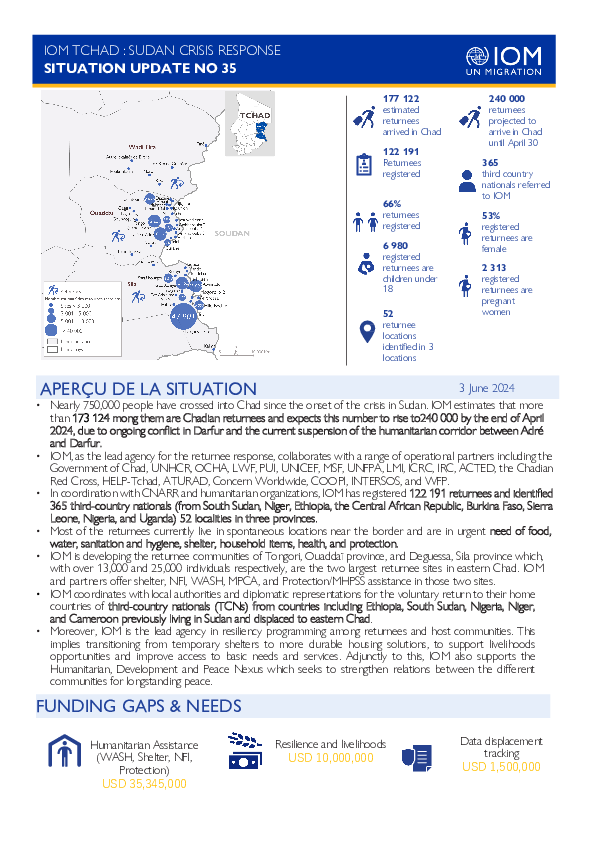
Contact
DTM Chad, dtmtchad@iom.int
Language
English
Location
Chad
Snapshot Date
Jun 03 2024
Activity
- Mobility Tracking
- Event Tracking
• Nearly 750,000 people have crossed into Chad since the onset of the crisis in Sudan. IOM estimates that more than 173 124 mong them are Chadian returnees and expects this number to rise to240 000 by the end of April 2024, due to ongoing conflict in Darfur and the current suspension of the humanitarian corridor between Adré and Darfur.
• IOM, as the lead agency for the returnee response, collaborates with a range of operational partners including the Government of Chad, UNHCR, OCHA, LWF, PUI, UNICEF, MSF, UNFPA, LMI, ICRC, IRC, ACTED, the Chadian Red Cross, HELP-Tchad, ATURAD, Concern Worldwide, COOPI, INTERSOS, and WFP.
• In coordination with CNARR and humanitarian organizations, IOM has registered 122 191 returnees and identified 365 third-country nationals (from South Sudan, Niger, Ethiopia, the Central African Republic, Burkina Faso, Sierra Leone, Nigeria, and Uganda) 52 localities in three provinces.
• Most of the returnees currently live in spontaneous locations near the border and are in urgent need of food, water, sanitation and hygiene, shelter, household items, health, and protection.
• IOM is developing the returnee communities of Tongori, Ouaddaï province, and Deguessa, Sila province which, with over 13,000 and 25,000 individuals respectively, are the two largest returnee sites in eastern Chad. IOM and partners offer shelter, NFI, WASH, MPCA, and Protection/MHPSS assistance in those two sites.
• IOM coordinates with local authorities and diplomatic representations for the voluntary return to their home countries of third-country nationals (TCNs) from countries including Ethiopia, South Sudan, Nigeria, Niger, and Cameroon previously living in Sudan and displaced to eastern Chad.
• Moreover, IOM is the lead agency in resiliency programming among returnees and host communities. This implies transitioning from temporary shelters to more durable housing solutions, to support livelihoods opportunities and improve access to basic needs and services. Adjunctly to this, IOM also supports the Humanitarian, Development and Peace Nexus which seeks to strengthen relations between the different communities for longstanding peace.
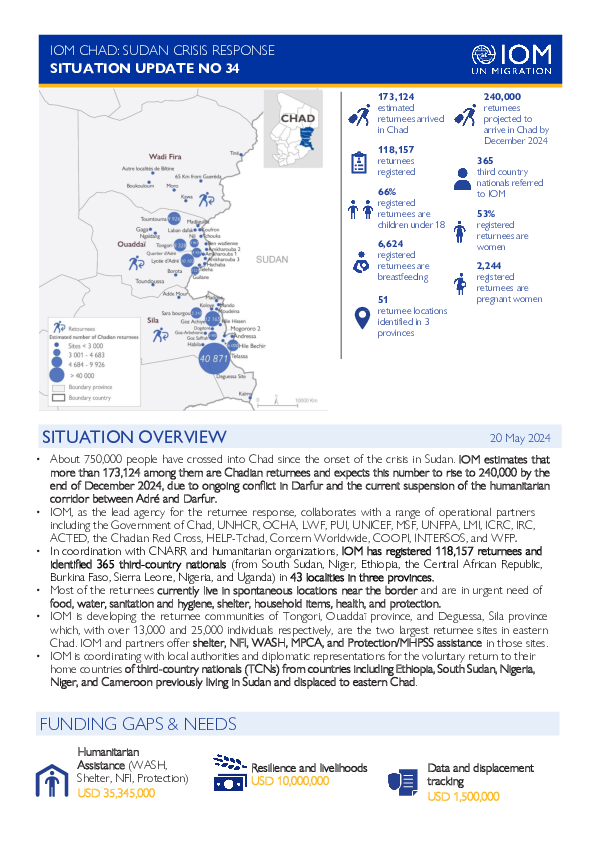
Contact
DTM Chad, dtmtchad@iom.int
Language
English
Location
Chad
Snapshot Date
May 20 2024
Activity
- Mobility Tracking
- Event Tracking
• About 750,000 people have crossed into Chad since the onset of the crisis in Sudan. IOM estimates that more than 173,124 among them are Chadian returnees and expects this number to rise to 240,000 by the end of December 2024, due to ongoing conflict in Darfur and the current suspension of the humanitarian corridor between Adré and Darfur.
• IOM, as the lead agency for the returnee response, collaborates with a range of operational partners including the Government of Chad, UNHCR, OCHA, LWF, PUI, UNICEF, MSF, UNFPA, LMI, ICRC, IRC, ACTED, the Chadian Red Cross, HELP-Tchad, Concern Worldwide, COOPI, INTERSOS, and WFP.
• In coordination with CNARR and humanitarian organizations, IOM has registered 118,157 returnees and identified 365 third-country nationals (from South Sudan, Niger, Ethiopia, the Central African Republic, Burkina Faso, Sierra Leone, Nigeria, and Uganda) in 43 localities in three provinces.
• Most of the returnees currently live in spontaneous locations near the border and are in urgent need of food, water, sanitation and hygiene, shelter, household items, health, and protection.
• IOM is developing the returnee communities of Tongori, Ouaddaï province, and Deguessa, Sila province which, with over 13,000 and 25,000 individuals respectively, are the two largest returnee sites in eastern Chad. IOM and partners offer shelter, NFI, WASH, MPCA, and Protection/MHPSS assistance in those sites.
• IOM is coordinating with local authorities and diplomatic representations for the voluntary return to their home countries of third-country nationals (TCNs) from countries including Ethiopia, South Sudan, Nigeria, Niger, and Cameroon previously living in Sudan and displaced to eastern Chad.
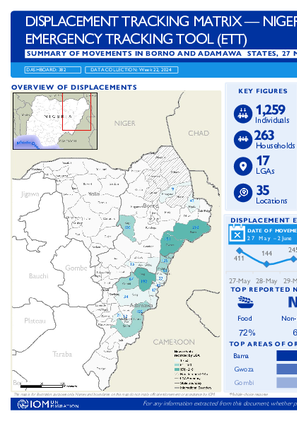
Contact
iomnigeriadtm@iom.int
Language
English
Location
Nigeria
Period Covered
May 27 2024
Jun 02 2024
Activity
- Registration
- Rapid Emergency Registration
Between 27 May and 2 June 2024, a total of 1,259 new arrivals were recorded at locations in Adamawa and Borno states. The new arrivals were recorded at locations in Askira/Uba, Bama, Gwoza, Kaga, Monguno, and Ngala Local Government Areas (LGAs) of the most conflict-affected Borno State and in Fufore, Gombi, Hong, Madagali, Maiha, Michika, Mubi North, Mubi South, Song, Yola North and Yola South LGAs of Adamawa State.
ETT assessments identified the following movement triggers: poor living conditions (396 individuals or 31%), military operation (313 individuals or 25%), seasonal farming (216 individuals or 17%), fear of attack (130 individuals or 10%), family re-unification (99 individuals or 8%), improved security (94 individuals or 7%) and access to humanitarian support (11 individuals or 1%).
Contact
dtmlebanon@iom.int
Location
Lebanon
Activity
- Mobility Tracking
- Baseline Assessment
Period Covered
Oct 10 2023 -May 28 2024
Since October 8 there has been an increase in cross-border incidents between Israel and Lebanon, resulting in the displacement of people both within the South and elsewhere within the country. Since October 10, the Displacement Tracking Matrix (DTM) has been conducting the daily monitoring of population movements. The objective of the exercise is to inform preparedness and response planning.
Aggregated data is available through the DTM API: https://dtm.iom.int/data-and-analysis/dtm-api
A more detailed version of this dataset is available, to get access kindly click on the 'Request Access' button
Population Groups
IDPs
Returnee (Previously Internally Displaced)
Survey Methodology
Unit of Analysis Or Observation
Admin Area 2
Admin Area 3
Household
Individual
Type of Survey or Assessment
Key Informant
Keywords
Geographical Scope Full Coverage
Administrative boundaries with available data
The current dataset covers the following administrative boundaries
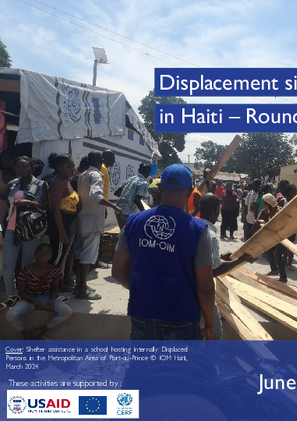
Contact
DTM Haiti, dtmhaiti@iom.int
Language
English
Location
Haiti
Period Covered
Apr 24 2024
May 31 2024
Activity
- Mobility Tracking
- Baseline Assessment
- Site Assessment
- Village Assessment
The Round 6, published in early March 2024, indicated that 362,551 people were
internally displaced in Haiti. This new Round indicates the presence of 578,074 internally displaced people, almost 60%
more than in Round 6. This increase is due to the deterioration of the security situation observed in the MAPAP, Haiti’s
capital, between the end of February and April 2024 in particular. The increase in the number of IDPs was more
identified in provinces where it increased by 95% (compared to 15% in the MAPAP). Indeed, following the increase in
violence in the MAPAP, many people fled the capital to seek refuge in provinces.
The Great South was the region that saw the largest increase in the number of IDPs hosted there (130% more
compared to Round 6). Nearly half (47%) of IDPs in the country are located in the Great South.
The majority of IDPs in the country are hosted in provinces: 68% in provinces vs. 32% in the MAPAP
The IDPs in provinces are mainly people who fled the MAPAP: 78% of IDPs in provinces came from the MAPAP.
Artibonite, where half of the IDPs fled areas located in this department, is an exception. In all other departments of the
country, IDPs mainly came from the MAPAP.
At the national level, the majority of IDPs are hosted by host families: 80% vs 20% in sites. However, in the MAPAP,
the majority of IDPs reside in sites (61% in sites vs 39% in host families), while in provinces the opposite is true (97% in
host families vs 3% in sites). It is crucial to support host communities in provinces, particularly in the Great South, to
enable them to continue hosting IDPs; and it is important to promote social cohesion between these two population
groups. Without the resilience of host communities, the number of sites in provinces is likely to increase as has been the
case in the MAPAP. Indeed, at the beginning of the crisis, the majority of IDPs in the MAPAP were hosted by host
families: only about 2 out of 10 IDPs were in sites in 2022; this figure increased to 6 out of 10 IDPs in 2023. One of the
main reasons for this increase was the lack of resources of host communities to continue hosting IDPs and the
deterioration of social cohesion in this context.
In addition, 50,000 returnees formerly IDPs were identified, particularly in the MAPAP, in Croix-des-Bouquets (21%),
Cité Soleil (14%), Port-au-Prince (12%); in the South in Tiburon (19%); and in the Center in Sauts d’Eau (10%). It should
be noted that for the moment these returns remain very fragile and are not sustainable, particularly in the MAPAP.
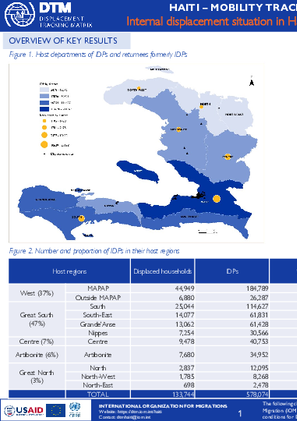
Contact
DTM Haiti, dtmhaiti@iom.int
Language
English
Location
Haiti
Period Covered
Feb 24 2024
May 31 2024
Activity
- Mobility Tracking
- Baseline Assessment
- Site Assessment
- Village Assessment
The Round 6, published in early March 2024, indicated that 362,551 people were
internally displaced in Haiti. This new Round indicates the presence of 578,074 internally displaced people, almost 60%
more than in Round 6. This increase is due to the deterioration of the security situation observed in the MAPAP, Haiti’s
capital, between the end of February and April 2024 in particular. The increase in the number of IDPs was more
identified in provinces where it increased by 95% (compared to 15% in the MAPAP). Indeed, following the increase in
violence in the MAPAP, many people fled the capital to seek refuge in provinces.
The Great South was the region that saw the largest increase in the number of IDPs hosted there (130% more
compared to Round 6). Nearly half (47%) of IDPs in the country are located in the Great South.
The majority of IDPs in the country are hosted in provinces: 68% in provinces vs. 32% in the MAPAP
The IDPs in provinces are mainly people who fled the MAPAP: 78% of IDPs in provinces came from the MAPAP.
Artibonite, where half of the IDPs fled areas located in this department, is an exception. In all other departments of the
country, IDPs mainly came from the MAPAP.
At the national level, the majority of IDPs are hosted by host families: 80% vs 20% in sites. However, in the MAPAP,
the majority of IDPs reside in sites (61% in sites vs 39% in host families), while in provinces the opposite is true (97% in
host families vs 3% in sites). It is crucial to support host communities in provinces, particularly in the Great South, to
enable them to continue hosting IDPs; and it is important to promote social cohesion between these two population
groups. Without the resilience of host communities, the number of sites in provinces is likely to increase as has been the
case in the MAPAP. Indeed, at the beginning of the crisis, the majority of IDPs in the MAPAP were hosted by host
families: only about 2 out of 10 IDPs were in sites in 2022; this figure increased to 6 out of 10 IDPs in 2023. One of the
main reasons for this increase was the lack of resources of host communities to continue hosting IDPs and the
deterioration of social cohesion in this context.
In addition, 50,000 returnees formerly IDPs were identified, particularly in the MAPAP, in Croix-des-Bouquets (21%),
Cité Soleil (14%), Port-au-Prince (12%); in the South in Tiburon (19%); and in the Center in Sauts d’Eau (10%). It should
be noted that for the moment these returns remain very fragile and are not sustainable, particularly in the MAPAP.

Contact
DTM Europe, DTMMediterranean@iom.int
Language
English
Location
Romania
Period Covered
Jan 01 2024
Mar 31 2024
Activity
- Survey
- Return Intention
- Flow Monitoring
IOM’s Displacement Tracking Matrix (DTM) collected data on Ukrainian nationals and TCNs (resided in Ukraine before 24 February 2022) that were crossing back to Ukraine from or through Romania, either temporarily or permanently. The survey focuses on the return intentions, duration of displacement, destinations, assistance, and experiences of discrimination of respondents. A total of 1,298 surveys were collected between January and March 2024. Among these, less than one per cent (n=11) were completed by TCNs, while the vast majority, comprising over 99 per cent (n=1,287), were completed by Ukrainian nationals. The analysis presented in this report is based on the responses provided by Ukrainian nationals.
Before crossing back into Ukraine, individuals commonly stayed in Romania (57%), other EU countries (36%) or non-EU countries (6%). Aside from Romania, other countries of residence were Bulgaria (18%), Germany (6%), Italy (4%) or Turkey (3%).
The travel intentions of the surveyed Ukrainian nationals show that most respondents (63%) were “short-term visitors”, while 15 per-cent were prospective returnees. Another 22 per cent were not sure regarding their visit period. Also, most UA citizens were travelling back to their oblast of origin (95%), with most respondents originating from Odeska, Chernivetska, City of Kiyv Mykolaivska or Kersonska.
